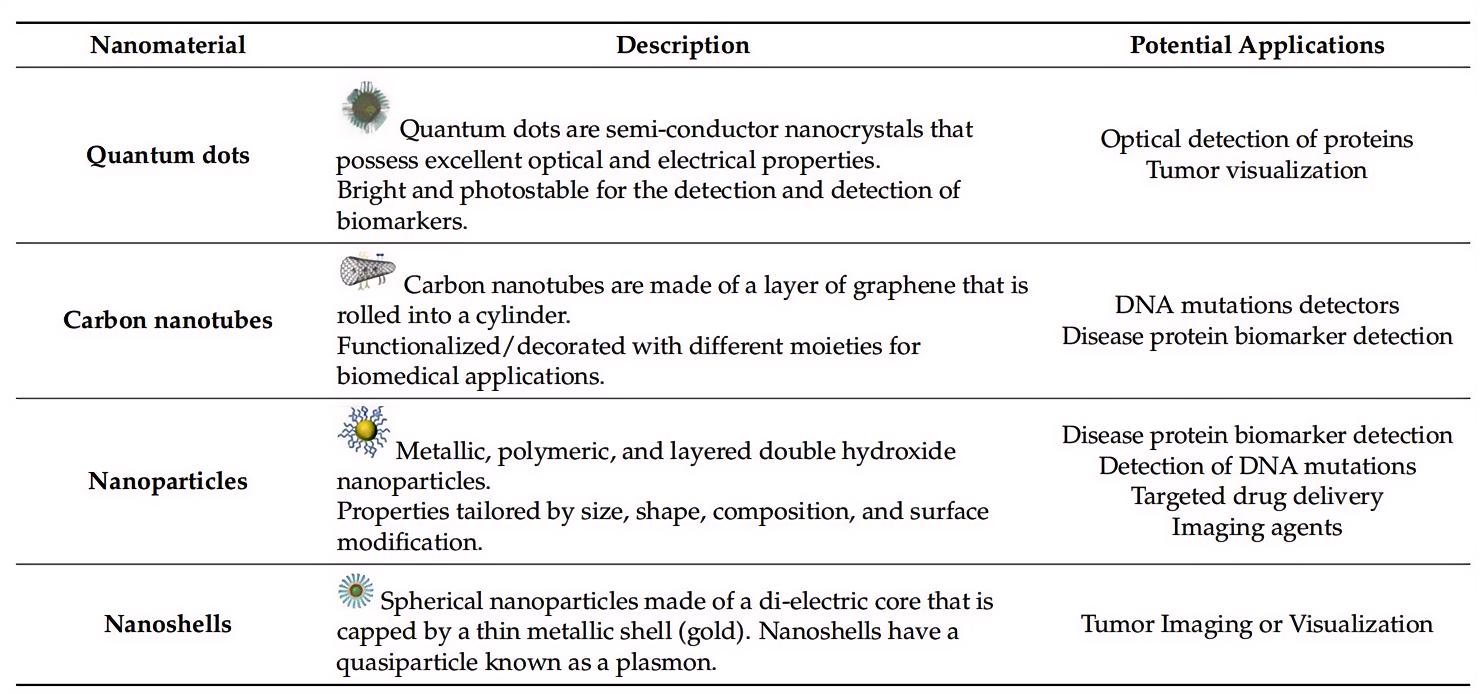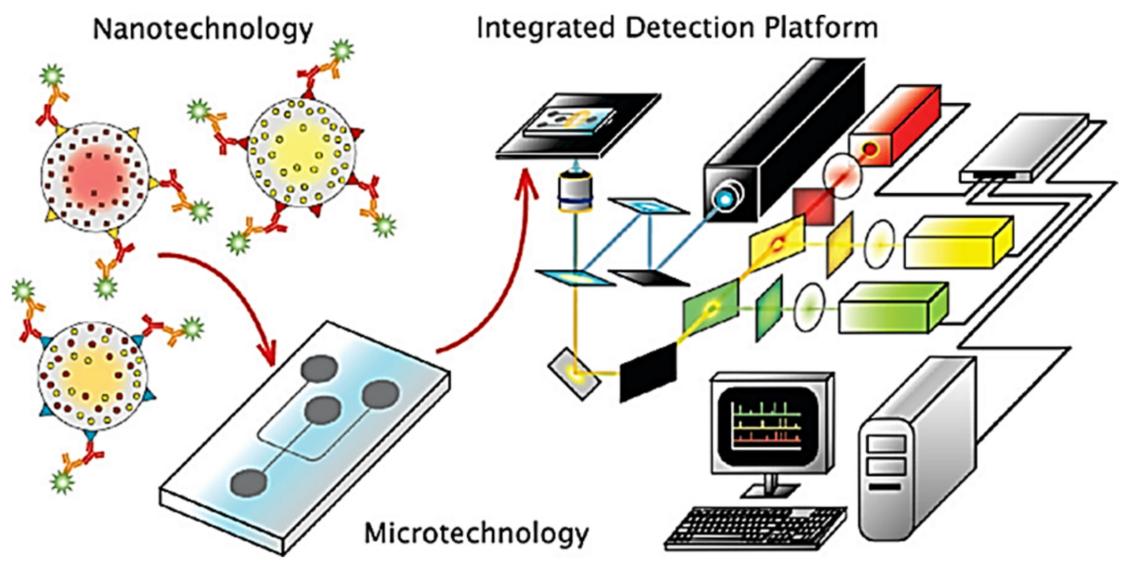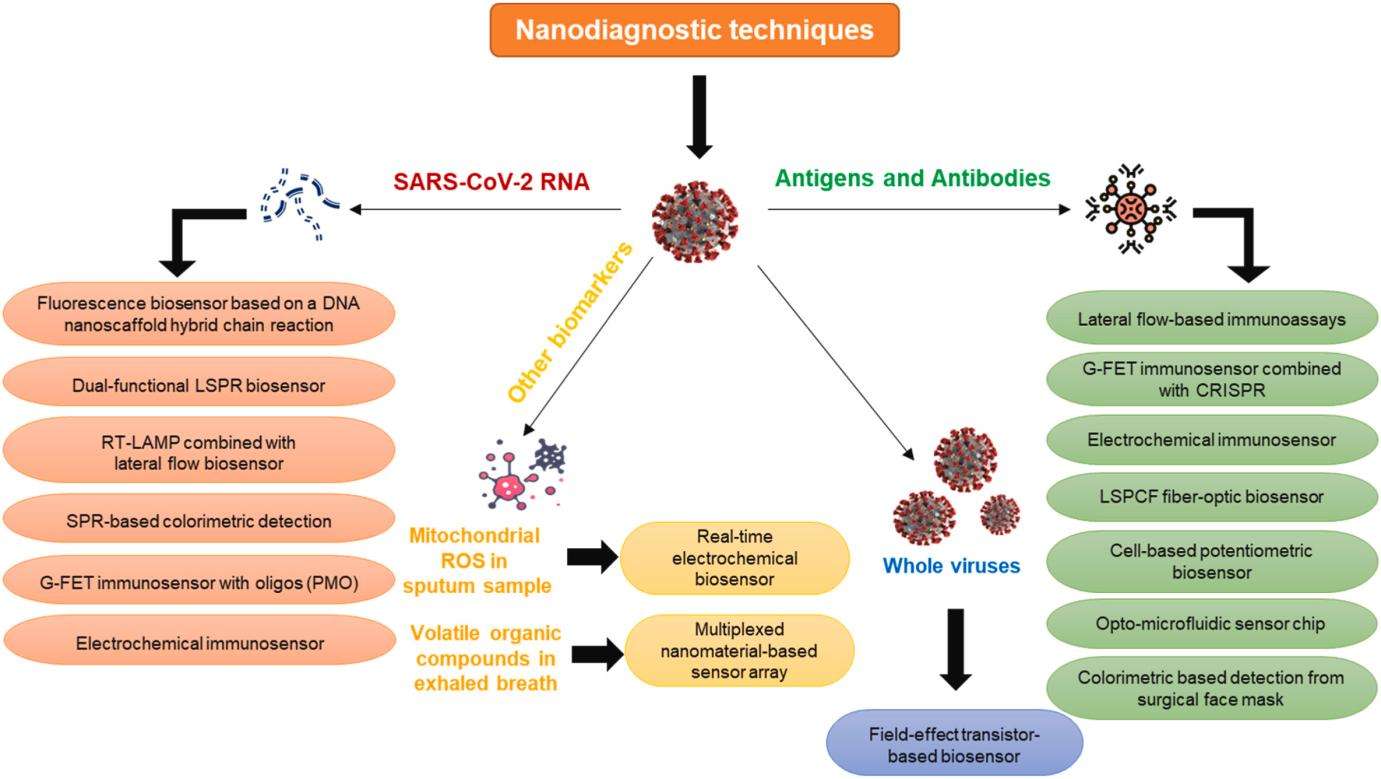Nanoformulation for Diagnostic Research
Inquiry
Nanodiagnostics utilizes nanoformulation properties to manipulate and analyze single-molecule systems and platforms for clinical diagnostics. Nanoformulations have unique physicochemical and optical properties that hold great potential for accurate and timely diagnosis of diseases. CD Formulation has established advanced nanotechnology platforms and can offer nanoformulation development services for diagnostic research.
Classification of Nanomaterials for Disease Diagnosis
With the rapid development of nanotechnology, disease diagnosis can be performed at the nanoscale, which provides new methods for patient sample evaluation and early detection of disease biomarkers with higher sensitivity and specificity. Various nanomaterials have been widely used in disease diagnosis, such as nanoparticles, quantum dots, nanotubes, nanowires, nanorobots, etc.
Table 1. Nanomaterials and their common applications in diagnostics. (Lungile Nomcebo Thwala, et al. 2023)

Nanotubes
Nanotubes are cylindrical carbon molecules with novel properties that make them exhibit extraordinary strength and unique electrical properties and are good conductors of heat energy. Carbon nanotubes and silicon nanowires have been widely used to detect various volatile organic compounds present in breath samples of lung and gastric cancer patients, respectively.
Quantum Dots
Quantum dots are inorganic crystalline nanomaterials that have fluorescence. Quantum dots can be combined with other diagnostic technologies to observe cells in living animals, perform immunofluorescence labeling of breast cancer markers, and use them for cancer imaging, etc.
Nanowires
Nanowires are nanometer-sized channels that allow electric current to pass through at extremely low amplitudes and are made of carbon nanotubes, metal oxides or silicon. When several nanowires with different antibodies attached are integrated into a single device, they can be used as detectors for diseases such as cancer to detect biomarkers of different cancers.
Nanorobots
Nanorobots are nanoscale robots, such as biochips and nanorobots, which have been used in medicine for early diagnosis and targeted drug delivery for cancer treatment, pharmacokinetic monitoring of diabetes, and healthcare.
Nanosensors
Nanosensors are non-invasive sensors that detect clinically relevant biomarkers in a variety of biological fluids such as tears, saliva and sweat, and can confirm the health status of the human body without sampling, complex operations and treatment.
Applications for Nanoformulations in Diagnostic Research
With the rapid development of nanoformulations and nanotechnology, nanoformulations have been widely applied in diagnostic research including infectious diseases (such as viral infections, bacterial infections, and parasitic diseases) and non-infectious diseases (such as cancers and cardiovascular diseases).
- Infectious Diseases: Pathogenic microorganisms such as viruses, fungi, bacteria and parasites have unique characteristics such as rapid reproduction, unpredictability and evolutionary advantages, and are the main source of infectious diseases.
- Non-Infectious Diseases: Diagnostics play an important role in non-communicable diseases including cystic fibrosis, most cancers, cardiovascular diseases, chronic respiratory diseases such as asthma and diabetes. Nanotechnology accelerates the development of non-communicable diagnostic research, making diagnosis more efficient and smarter.
Our Nanotechnology Platforms for Diagnostic Research
CD Formulation has focused on nanotechnology platforms for years, including nanomaterials (such as quantum dots, various types of nanoparticles, including fluorescent, magnetic, and metallic nanoparticles), microfluidic chips, lateral flow immunoassay chips, etc.
Nanoparticle-based Platform for Diagnostic Research
We have been committed to the development and optimization of nanoparticle platforms for the detection of pathogens and cancer biomarkers for many years.
Microfluidic Chip Platform for Diagnostic Research
Microfluidic diagnostic chips have special qualities that make them suitable for point-of-care diagnostic applications, including modularity, mobility, low reagent and sample consumption, and high sensitivity. We develop microfluidic platforms that integrate various technologies, such as lab-on-a-chip devices, by integrating microfluidics, microelectrochemical systems, nanotechnology, and material science.
 Fig.1 Illustration of the integration of quantum dots, solution-based sandwich assay, microfluidics and fluorescence detection with custom software for high-throughput, multiplexed blood-borne pathogen detection. Reproduced with consent from. (Lungile Nomcebo Thwala, et al. 2023)
Fig.1 Illustration of the integration of quantum dots, solution-based sandwich assay, microfluidics and fluorescence detection with custom software for high-throughput, multiplexed blood-borne pathogen detection. Reproduced with consent from. (Lungile Nomcebo Thwala, et al. 2023)
Lateral Flow Immunoassay Chip Platform for Diagnostic Research
Lateral flow immunoassay chips contain SiO2 cores with 20 nm gold nanoparticles and quantum dots, which can be used to diagnose diseases by naked eye and fluorescence detection. Its colorimetric function can realize on-site diagnosis, and its fluorescence function can quantify the virus.
Why Choose CD Formulation?
- We can provide customers with customization of various nanomaterials for diagnostic research, such as nanoparticles, quantum dots, nanotubes, nanowires, nanorobots, etc.
- We also are interested in exploring and researching novel nanodiagnostics platforms, such as developing nanotechnology-based biochips used for detecting and analyzing biomoleculars.
- Nanodiagnostic technologies we can research and develop include but are not limited to nanoparticle biolabels, nanoscale visualization, biochips/microarrays, nanoproteome-based diagnostics, nanoparticle-based nucleic acid diagnostics, nanoparticle-based immunoassays, DNA nanomachines, Nanobiosensors, biological barcode assays, and nanopore technology.
Published Data
Technology: Nanotechnology-based diagnostic devices for COVID-19
Journal: Biosensors and Bioelectronics: X
IF: 4.60
Published: 2022
Results:
The authors discuss technologies used for COVID-19 diagnosis and present the advantages of nanotechnology-based diagnostic devices over other technologies. Nanodiagnostic devices are biosensing platforms developed using nanomaterials (e.g., nanoparticles, nanotubes, nanowires, etc.) that have advantages over traditional technologies such as reverse transcription polymerase chain reaction, including ease of use, faster analysis, potential miniaturization, and scope for use in point-of-care treatments. Nanodiagnostic devices therefore have potential applications in clinical and point-of-care settings and in personalized healthcare.
 Fig.2 Schematic representation of the nanotechnology-based diagnostic devices. (Mosam Preethi, et al. 2022)
Fig.2 Schematic representation of the nanotechnology-based diagnostic devices. (Mosam Preethi, et al. 2022)
With the in-depth development and application exploration of nanoformulations, nanoformulations, as a nanodiagnostic technology, are widely used to monitor depression, hypertension, diabetes, cancer and various infectious diseases. CD Formulation offers innovative nanoformulation development services for diagnostic research. Our cutting-edge technology and expert team enable us to deliver tailored, high-performance solutions that enhance diagnostic test accuracy and efficiency. If you are interested in nanodiagnostic technologies, please contact us to discuss your further requirements.
References
- Lungile Nomcebo Thwala, Sphumelele Colin Ndlovu, Kelvin Tafadzwa Mpofu, et al. Nanotechnology-Based Diagnostics for Diseases Prevalent in Developing Countries: Current Advances in Point-of-Care Tests. Nanomaterials. 2023,13(7):1247.
- Mosam Preethi, Lavanika Roy, Sukanya Lahkar, et al. Outlook of various diagnostics and nanodiagnostic techniques for COVID-19. Biosensors and Bioelectronics: X. 2022, 12:100276
How It Works
STEP 2
We'll email you to provide your quote and confirm order details if applicable.
STEP 3
Execute the project with real-time communication, and deliver the final report promptly.
Related Services



 Fig.1 Illustration of the integration of quantum dots, solution-based sandwich assay, microfluidics and fluorescence detection with custom software for high-throughput, multiplexed blood-borne pathogen detection. Reproduced with consent from. (Lungile Nomcebo Thwala, et al. 2023)
Fig.1 Illustration of the integration of quantum dots, solution-based sandwich assay, microfluidics and fluorescence detection with custom software for high-throughput, multiplexed blood-borne pathogen detection. Reproduced with consent from. (Lungile Nomcebo Thwala, et al. 2023) Fig.2 Schematic representation of the nanotechnology-based diagnostic devices. (Mosam Preethi, et al. 2022)
Fig.2 Schematic representation of the nanotechnology-based diagnostic devices. (Mosam Preethi, et al. 2022)
